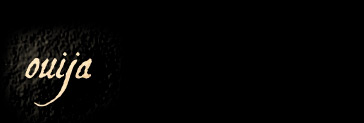 |
History | People | Boards | Stencils | Patents & Trademarks | Factories | Advertisements | Articles | Entertainment | Customer Letters | Other
Patents and Trademarks
William Fuld | Carrie Fuld | William A Fuld | Isaac Fuld
William Andrew Fuld
October 1st 1893 - November 19th 1976
Click any picture below to enlarge it and begin a photo gallery
*Your browser must allow popups to view the photo galleries
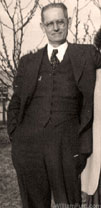 |
| William Andrew Fuld |
William Andrew Fuld was the heir apparent to his father's Ouija board empire. Having worked at the business since he was sixteen it makes sense he would have the second most Ouija board patents and trademarks in the family. Besides the registrations that became his upon the death of his father he had two U.S. patents, three U.S. trademarks, one Canadian patent, and one Canadian trademark. All together that's seven Ouija board registrations! Among them is a design patent which is the most recognizable Ouija design and closest to what the Ouija board looks like today. However, his most famous Ouija board and patent is the Electric Mystifying Oracle. It was also his very first Ouija patent. Way ahead of its time it brought battery technology of the time to a Victorian parlor game. Probably the most interesting of any of the Fuld's Ouija boards it didn't sell, making it one of the most sought after Ouija boards of all time.
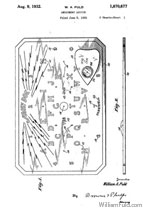 |
William Andrew Fuld
Patent No. 1,870,677 |
U.S. Patents
Patent No. 1,870,677
August 9th 1932
William Andrew's first talking board patent as quite the undertaking. Besides its new bat-like layout this talking board used a battery and was made of metal. Unlike any talking board that came before it William Andrew gambled that the time was right to play the Electric Mystifying Oracle in the dark. The battery holding planchette would hit raised metal buttons on the board causing the bulb under the planchette to light up. The timing was off and not many of these boards sold. The patent is fascinating reads “This invention relates to amusement devices and has an object the provision of a board of the nature of the well-known “Ouija” board having a plaque moveable thereover with means to cause an illumination of the characters formed or indicated upon the board by movements of the plaque. It is a further object of the invention to provide a board having protuberances thereon and a plaque moveable over the board carrying an illuminating device preferably an electric lamp and battery having a switch adapted to be closed by contact with any one of said protuberances.”
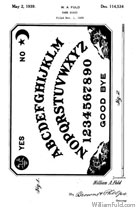 |
William Fuld
Design Patent No. 114,534 |
Design Patent No. 114,534
May 2nd 1939
Following in his father's footsteps William Andrew used patent and trademark registrations to protect the Ouija board. He registered this design patent on how the Ouija board looked. This design is very similar to what the Ouija board looks like today. Most notably missing are the sun and faced crescent moon. The first version of the drawn people playing the Ouija board in the bottom corners of the board are present. The registration reads “Be it Known that I, William A. Fuld, a citizen of the United States, residing at Baltimore, independent city, State of Maryland, have invented a new, original, and ornamental Design for a game board, of which the following is a specification, reference being had to the accompanying drawing, forming part thereof. Figure 1 is a top plan view; and Figure 2 is an edge elevation of a game board, showing my new design. The ornamental design for a game board, substantially is shown.”
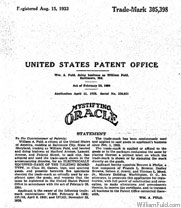 |
William Andrew Fuld
Trademark No. 305,398 |
U.S. Trademarks
Trademark No. 305,398
August 15th 1933
Though the words Mystifying Oracle had been trademarked by the Fulds before those registrations didn't cover anything considered electronic. Because the Electric Mystifying Oracle was a completely new invention, William Andrew needed to secure a trademark specifically for it. It reads “William A. Fuld, a citizen of the United States of America, residing at Baltimore City, State of Maryland, trading as William Fuld, and located and doing business at Harford Avenue, Lamont Avenue, and Federal Street, in said city, has adopted and used the trade-mark shown in the accompanying drawing, for an ELECTRICALLY EQUIPPED GAME OF THE TALKING BOARD TPE, in class 22, Games, toys, and sporting goods, and presents herewith five specimens showing the trade-mark as actually used by applicant upon the goods, and requests that the same be registered in the United States Patent Office in accordance with the act of February 20, 1905.”
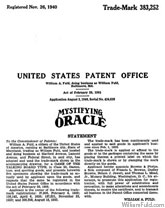 |
William Andrew Fuld
Trademark No. 383,252 |
Trademark No. 383,252
November 26th 1940
This is the last registration the Fuld's filed for the words Mystifying Oracle and is the same one in use and owned by Hasbro to this day. Today it is used in conjunction with the trademark on the word Ouija as “Ouija the Mystifying Oracle.” The registration reads “William A. Fuld, a citizen of of the United States of America, residing at Baltimore city, State of Maryland, trading as William Fuld, and located and doing business at Harford Avenue, Lamont Avenue, and Federal Street, in said city, has adopted and used the trade-mark shown in the accompanying drawing, for a GAME OF THE TALKING BOARD TYPE, in Class 22, Games, toys, and sporting goods, and presents herewith five specimens showing the trade-mark as actually used by applicant upon the goods, and requests that the same be registered in the United States Patent Office in accordance with the act of February 20, 1905.”
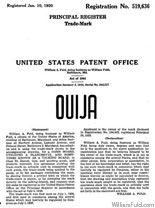 |
William Andrew Fuld
Trademark No. 519,636 |
Trademark No. 519,636
January 10th 1950
Sadly, this is the last registration the Fuld's filed for the words Ouija and is the same one in use and owned by Hasbro to this day. The registration reads “William A. Fuld, doing business as William Fuld, a citizen of of the United States of America, residing at Baltimore, Maryland, doing business at Harford Avenue, Lamont Avenue, and Federal Street, Baltimore 2, Maryland, has adopted and is using the trade-mark shown in the accompanying drawing, for a GAME BOARD, UTILIZING A PLANCHETTE, AND SOMETIMES KNOWN AS A TALKING BOARD, in Class 22, Games, toys, and sporting goods, and presents herewith five specimens showing the trade-mark as actually used in connection with such goods, the trade-mark being applied to such goods, or to the packages containing the same, by placing thereon a printed label on which the trade-mark is shown, or by stamping the mark directly on the talking-boards, and requests that the same be registered in the United States Patent Office on the Principal Register in accordance with the act of July 5, 1946.”
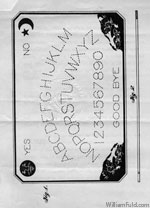 |
William Andrew Fuld
D-4712 No. 62 Folio 12,685 |
Canadian Patents
Design Patent D-4712 No. 62 Folio 12,685
March 27th 1940
William Andrew had just one Canadian patent and it was registered on the design and layout of a talking board. Like its U.S. registration, it depicts a design very similar to what we see on today's Ouija boards. It reads “I, William A, Fuld, of Harford Avenue, Lamont Avenue, and Federal Street, the City of Baltimore, State of Maryland, United States of America, hereby request you to register in my name and Industrial Design for a Game Board, of which I am the proprietor. I declare that the said Industrial Design was not in use to my knowledge by any other person than myself at the time of my adoption thereof. The following is a description of the said industrial design with reference to the attached drawings, in which Figure 1 is a top plan view; and Figure 2 is an edge elevation of a game board showing my new design. The design covered by this application is an octagonal game board having representations of humans in its two lower corners and representation of the moon in its upper left corner, representation of a star and crescent in its upper right corner and characters over the field of the board, the whole as indicated on the enclosed pattern or design.”
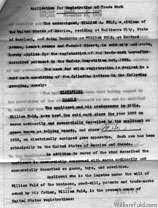 |
William Fuld
Trademark N.S. 1011/3 |
Canadian Trademarks
Trademark N.S. 1011/3
November 2nd 1933
Because of the Mystifying Oracle's success in the States William Andrew filed for this Canadian trademark which interestingly enough included its electrical use. It reads “The undersigned, William A. Fuld, a citizen of the United States of America, residing at Baltimore City, State of Maryland, and doing business as William Fuld, at Harford Avenue, Lamont Avenue, and Federal Street, in said city and state, hereby applies for the registration of the trade-mark hereafter described pursuant to the Unfair Competition Act, 1932. The mark for which registration is desired is a word mark consisting of the following letters in the following grouping, namely; MYSTIFYING ORACLE. The applicant and his predecessor in title, William Fuld, have used the said mark since the year 1896 on wares ordinarily and commercially described by the applicant as games known as talking boards, and since February 1, 1933, on electrically equipped game apparatus. Such use has been principally in the United States and Canada. In addition to wares of the kind described the applicant is commercially concerned with wares ordinarily and commercially described as games, toys, and novelties. Applicant who is the legatee under the will of William Fuld of the business, good-will, patents and trade-marks owned by his father, William Fuld, is the present owner of United States registrations.”
|








